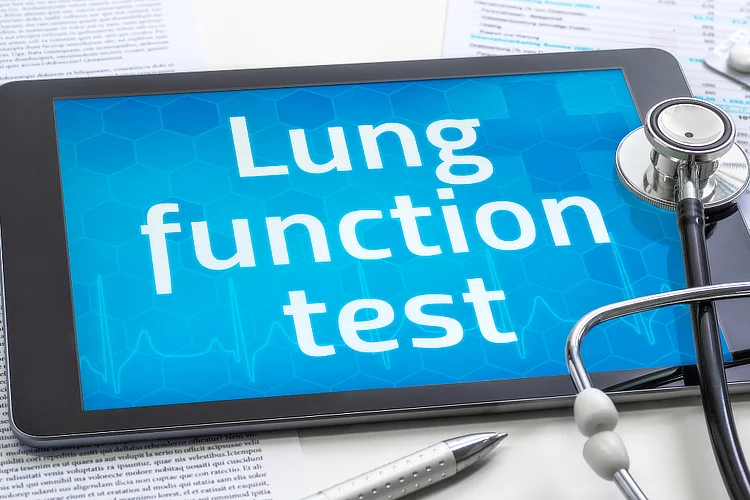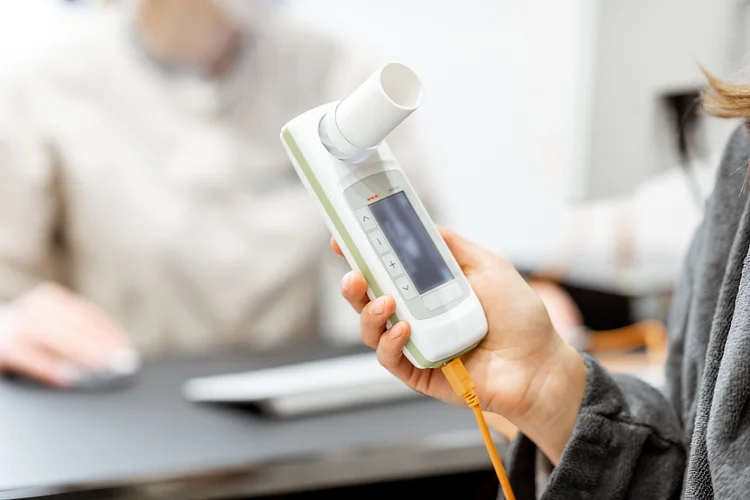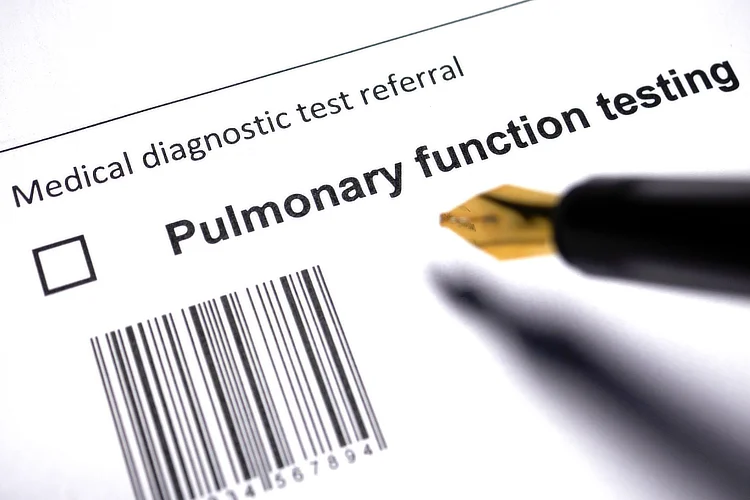Spirometry | Lung Function Test
Last updated: Dec 20, 2025
What Is the Purpose of a Spirometry Test?
Spirometry is a non-invasive lung function test that evaluates your
breathing capacity by measuring the volume of air you inhale and exhale, along with the
speed of your breath. It is widely used in the diagnosis and ongoing management of
respiratory conditions including asthma, chronic
obstructive pulmonary disease (COPD), and other airway disorders.
During the procedure, you take a full breath and blow forcefully into a device called a
spirometer. The readings captured help identify early signs of lung impairment, support
treatment planning, and allow healthcare providers to track how your condition responds
over time.

When Is Spirometry Recommended?
Spirometry may be recommended for several reasons, including:
- Diagnosing chronic lung conditions such as asthma, COPD, or other respiratory diseases.
- Evaluating ongoing respiratory symptoms like chronic cough, wheezing, or shortness of breath.
- Monitoring disease progression and treatment response in individuals with known lung conditions.
- Assessing lung function before surgery to evaluate pre-operative risk.
- Screening individuals in high-risk occupations who are exposed to dust, fumes, or other airborne irritants.
The frequency and purpose of spirometry depend on your individual health status and the recommendations of your doctor.
How Is a Spirometry Test Performed?
A spirometry test typically involves sitting upright and breathing into a disposable mouthpiece connected to a spirometer. A nose clip may be used to ensure all air is exhaled through the mouth. The test usually takes about 15 to 30 minutes. The typical steps include:
- Taking a deep breath in.
- Sealing your lips tightly around the mouthpiece.
- Blowing out as hard and fast as possible until your lungs feel empty.
- Repeating the process several times to obtain consistent readings.
A doctor or healthcare professional will guide you through each attempt and ensure the technique is performed correctly to help achieve accurate results.

Spirometry Test Results Interpretation
Spirometry results are assessed using key measurements, primarily FEV₁, FVC, and the FEV₁/FVC ratio:
- FEV₁ (Forced Expiratory Volume in 1 Second) – The volume of air you can forcefully exhale in the first second of the test. This is a key indicator used to assess the severity of airflow obstruction.
- FVC (Forced Vital Capacity) – The total volume of air exhaled after taking a full, deep breath.
- FEV₁/FVC Ratio – The proportion of your lung capacity exhaled in the first second, used to detect airflow limitation and help differentiate between obstructive and restrictive lung conditions.
These values are compared against reference ranges based on your age, sex, height, and
ethnicity to determine if your lung function is within expected limits.
A low FEV₁ or FEV₁/FVC ratio may indicate obstructive lung diseases such as asthma or COPD.
In contrast, a reduced FVC with a normal or elevated FEV₁/FVC ratio may suggest a
restrictive lung condition.
Your doctor will interpret the results in the context of your symptoms, medical history,
and, if needed, other diagnostic tests.

Are There Any Risks With Spirometry?
Spirometry is generally considered low risk when performed by trained professionals, but it may not
be suitable for everyone. Some individuals may experience brief lightheadedness, dizziness, or
fatigue due to the effort required during forceful exhalation.
The test may be avoided or postponed in certain situations, such as:
- Recent chest, abdominal, brain, or eye surgery.
- Cardiac conditions such as a recent heart attack, severe arrhythmias, decompensated heart failure, or uncontrolled high blood pressure.
- Infectious diseases such as active tuberculosis or COVID-19, due to the risk of transmission during the test.
- Conditions affected by increased internal pressure, such as cerebral or aortic aneurysms.
- Late-term pregnancy, where spirometry may place additional strain.
Always inform your doctor of any existing health conditions before undergoing the test, so they can determine whether spirometry is appropriate for you.
Spirometry Test Cost in Singapore
At ATA Medical, we provide spirometry testing and treatment for asthma at the following rates:
| Test / Treatment | Price* |
|---|---|
| Consultation | From $49.05 |
| Spirometry | $54.50 |
| Asthma Medications | From $0.55 per tab |
| Asthma Inhalers | From $38.15 |
We also offer workplace
health screening services for corporate clients, which may include spirometry testing
depending on the nature of the job and industry requirements.
Our occupational health
doctors are experienced in assessing lung function for work-related risk management and
fitness-to-work evaluations.
Contact
us to learn more or discuss a customised screening package for your organisation.
How to Prepare for a Spirometry Test
To help ensure accurate results, it is important to follow certain preparation guidelines:
- Wear loose, comfortable clothing.
- Avoid eating a heavy meal before the test.
- Refrain from smoking, consuming alcohol, or engaging in vigorous exercise for at least a few hours beforehand.
- You may also be advised to temporarily stop using certain inhaled medications, depending on your doctor’s instructions.
It is best to follow your doctor’s specific instructions for the test, as recommendations may vary based on your individual health needs.
Spirometry Test Near Me
ATA Medical @ Orchard
Nearest MRT: Orchard Boulevard Station (TE13)
Contact Number: 6223 0682
Email: camden@atamed.sg
Opening Hours:
Mon - Fri: 8:30 AM to 12:30 PM, 1:30 PM to 5:30 PM
Sat: 8:30 AM to 12:30 PM
Sun & PH: Closed
ATA Medical @ Tanjong Pagar
Nearest MRT: Tanjong Pagar Station (EW15)
Contact Number: 6223 0682
Email: hi@atamed.sg
Opening Hours:
Mon - Fri: 8:30 AM to 12:30 PM, 1:30 PM to 5:30 PM
Sat: 8:30 AM to 12:30 PM
Sun & PH: Closed


